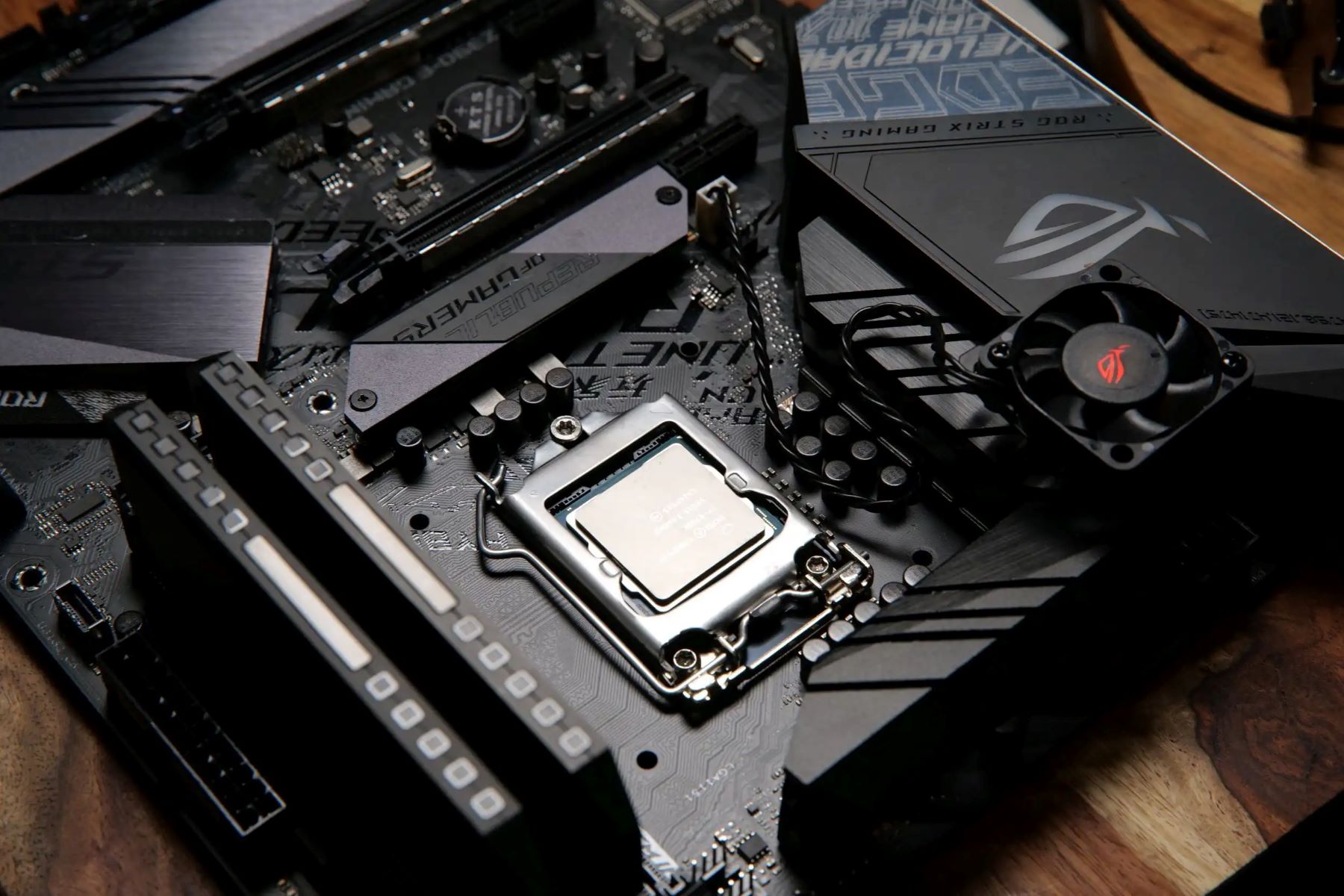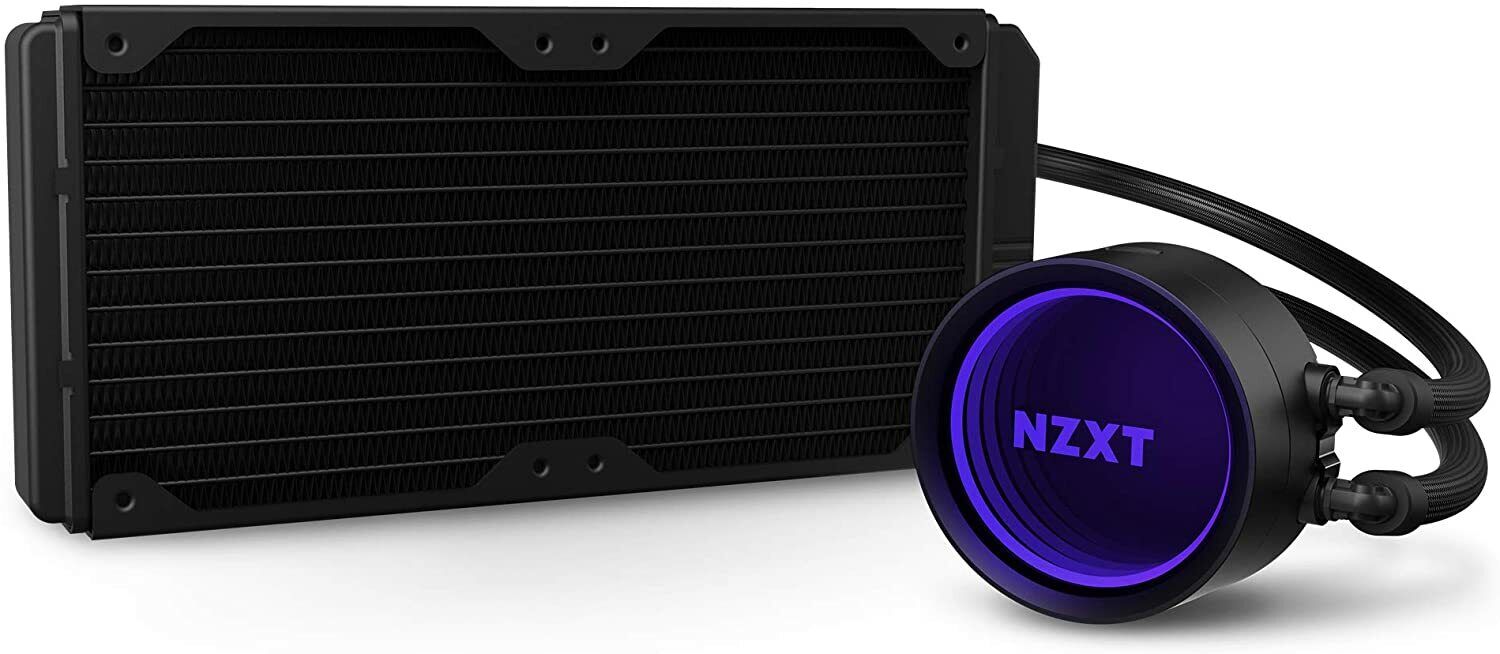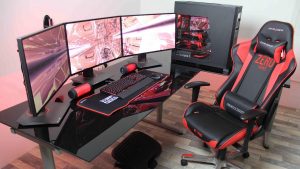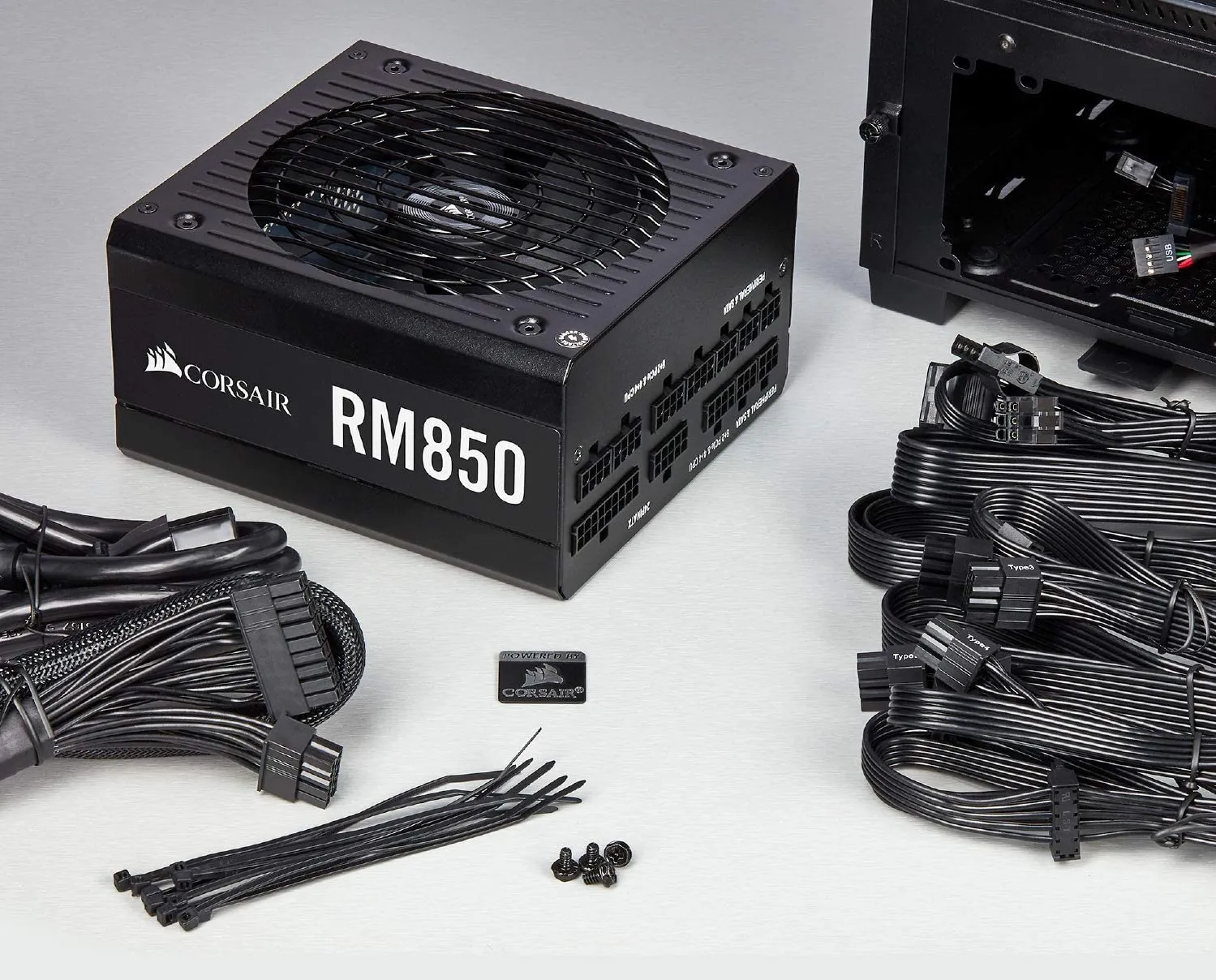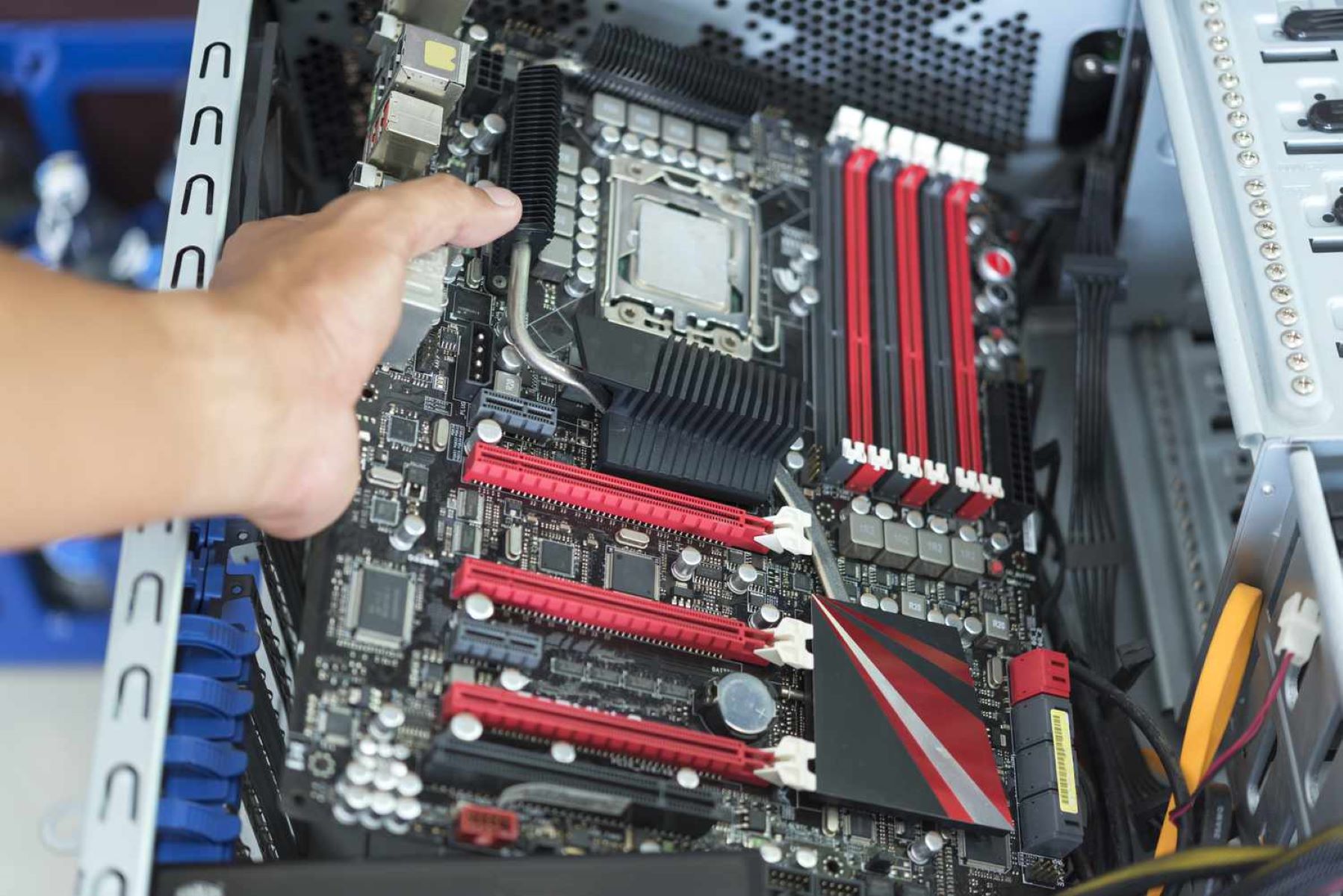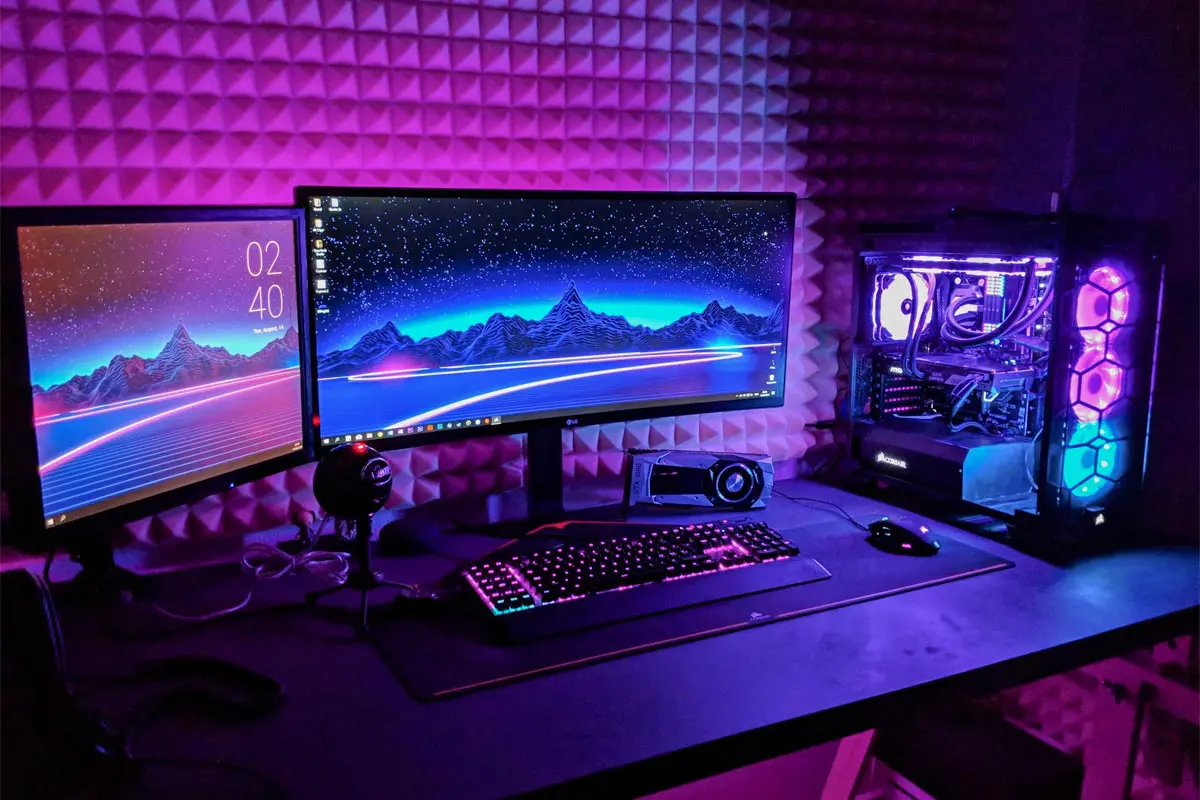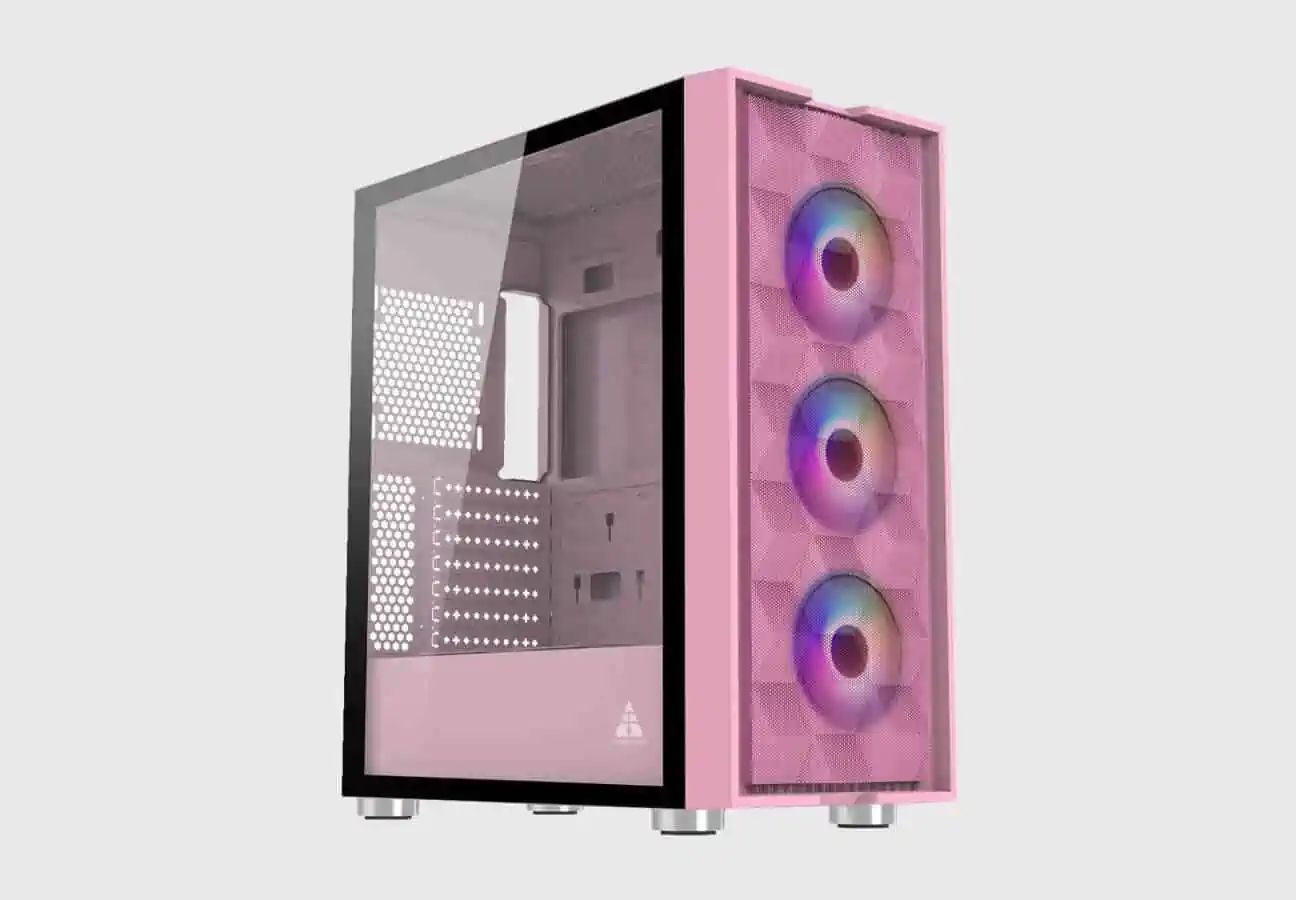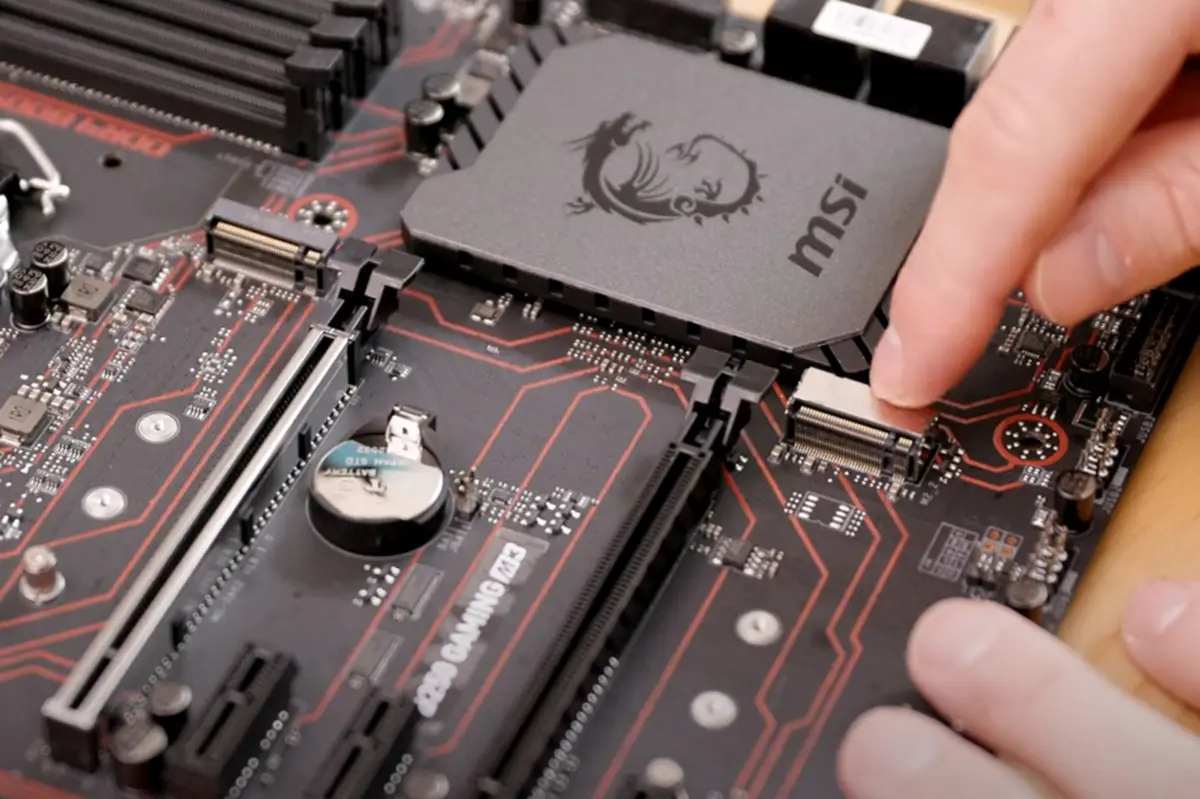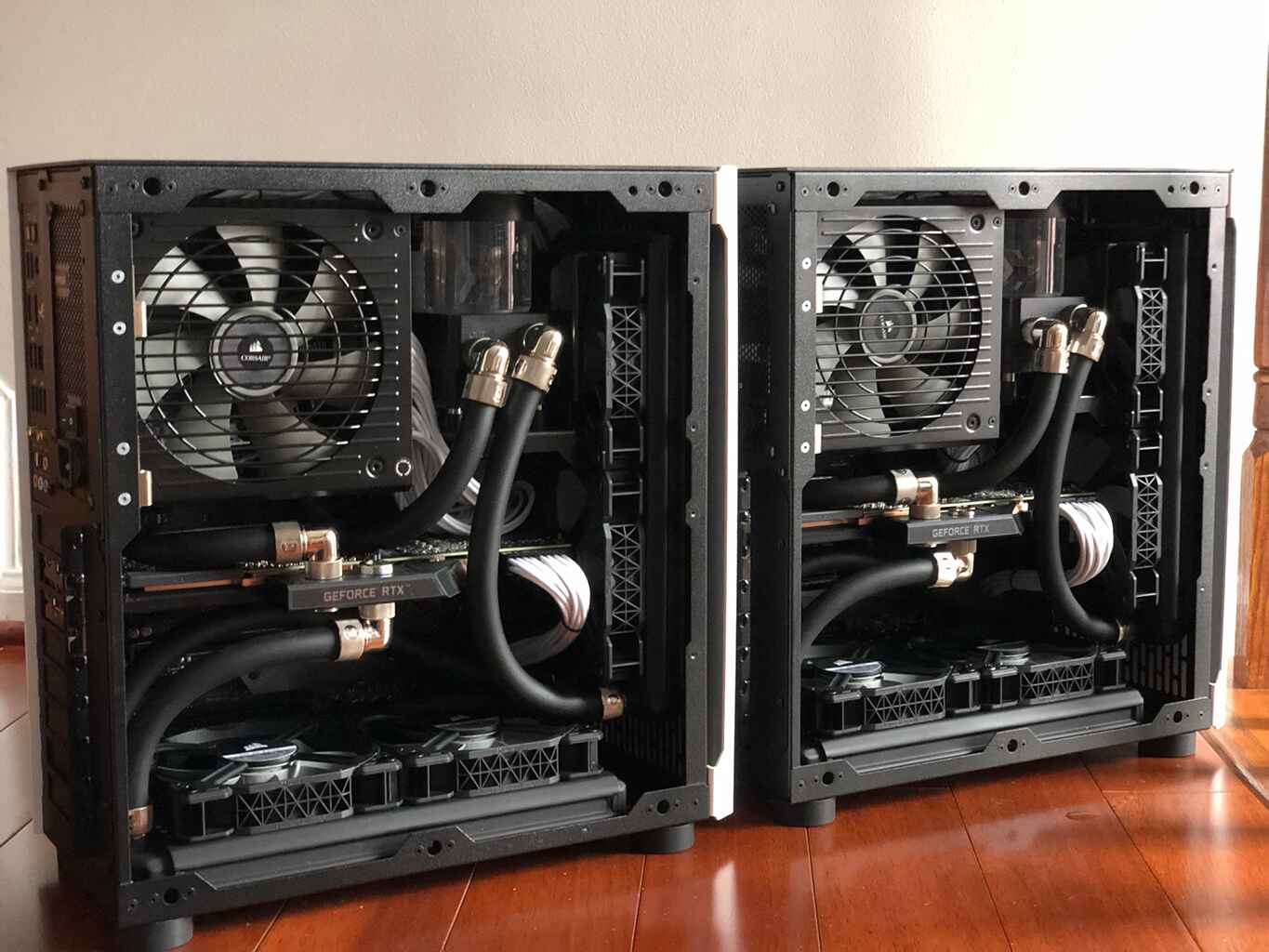Introduction
The motherboard is one of the most crucial components of a computer system. It acts as the foundation that connects all the other hardware components together, allowing them to work in harmony. Choosing a good motherboard is essential to ensure optimal performance and compatibility with your specific needs.
When searching for a motherboard, there are several key factors to consider. These include compatibility, form factor, CPU socket, RAM slots, expansion slots, storage interfaces, USB ports, networking capabilities, audio quality, BIOS (Basic Input/Output System), power delivery, and cooling options. Understanding these components and their importance can help you make an informed decision when selecting a motherboard for your system.
Compatibility is crucial as it determines whether the motherboard will be able to support your desired processor, RAM, and other hardware components. It’s important to ensure that the motherboard not only fits physically into your computer case but also supports the necessary connections and functionalities.
The form factor of the motherboard refers to its size and shape. The most common form factors are ATX, Micro ATX, and Mini ITX. The form factor you choose will determine how many expansion slots, RAM slots, and other features your motherboard can accommodate.
The CPU socket is where the processor is installed on the motherboard. Different CPUs have different socket types, so it’s crucial to choose a motherboard that is compatible with the specific processor you plan to use.
RAM slots determine the amount and type of RAM that can be installed on the motherboard. Consider the number of RAM slots available and the maximum capacity supported when selecting a motherboard.
Expansion slots allow you to add additional components to your system, such as graphics cards, sound cards, and networking cards. Make sure the motherboard has enough expansion slots and supports the type of cards you need.
Storage interfaces determine the type and number of storage devices, such as hard drives and solid-state drives, that can be connected to the motherboard. Common interfaces include SATA and M.2.
USB ports are essential for connecting external devices like keyboards, mice, and thumb drives. Ensure that the motherboard has an adequate number and a variety of USB ports to meet your needs.
Networking capabilities, including Ethernet ports and built-in Wi-Fi, are important if you rely on a wired or wireless internet connection. Consider your networking requirements when selecting a motherboard.
The quality of onboard audio is often overlooked but can significantly impact your overall computing experience. Look for motherboards with high-quality audio components or consider additional sound cards if audio quality is important to you.
BIOS, the firmware that controls hardware initialization and configuration, is stored on the motherboard. A user-friendly BIOS interface can make system configuration and troubleshooting much easier.
Power delivery refers to the ability of the motherboard to provide stable and efficient power to the components. A good motherboard should have reliable power delivery mechanisms to ensure optimal performance and prevent system instability.
Cooling options, such as fan headers and heatsinks, contribute to the overall temperature management of your system. Look for motherboards that offer sufficient cooling features to prevent overheating and maintain system longevity.
Compatibility
One of the most important considerations when selecting a motherboard is compatibility. Compatibility determines whether the motherboard will work seamlessly with the other components of your computer system. It ensures that each component can communicate effectively, maximizing performance and minimizing potential compatibility issues.
The first aspect of compatibility to consider is the physical fit of the motherboard in your computer case. Motherboards come in different form factors, such as ATX, Micro ATX, and Mini ITX. Make sure to choose a motherboard that matches the form factor supported by your computer case. This ensures that the motherboard will fit properly and align with the screw holes for secure installation.
Another crucial compatibility factor is the processor socket type. The CPU socket on the motherboard is specifically designed to accommodate a certain type of processor. Different processors, such as Intel and AMD, use different socket types. It is essential to choose a motherboard that has the correct CPU socket for your processor. Failure to do so will result in the processor being physically incompatible with the motherboard, rendering it useless.
RAM compatibility is another aspect to consider. Motherboards support specific types of RAM, such as DDR3 or DDR4, and have a maximum supported RAM capacity. Make sure the motherboard you choose supports the type and amount of RAM you plan to install in your system.
Expanding beyond the CPU and RAM, it’s essential to check the compatibility of other components as well. This includes checking for adequate expansion slots for add-on cards, such as graphics cards, sound cards, and networking cards. Ensure that the motherboard supports the specific types of expansion cards you intend to use.
Storage compatibility is also important. Determine if the motherboard supports the appropriate storage interfaces, such as SATA or M.2, for your hard drives or solid-state drives. Some motherboards also offer support for newer storage technologies, such as NVMe, which can significantly improve storage speeds.
Additionally, consider the compatibility of other peripherals, such as USB devices. Ensure that the motherboard has a sufficient number of USB ports and supports the desired USB standards to accommodate your devices.
Lastly, consider the operating system compatibility. Most modern motherboards support popular operating systems like Windows, Linux, and macOS. However, double-check the manufacturer’s specifications to confirm compatibility with the operating system you plan to use.
By prioritizing compatibility, you can avoid issues such as physical incompatibility, non-functioning components, and system instability. Take the time to research and verify compatibility between your chosen components and the motherboard to ensure a smooth and hassle-free computing experience.
Form Factor
The form factor of a motherboard refers to its physical size and shape. It determines the dimensions and layout of the motherboard, which in turn affects the number of connectors, ports, and expansion slots it can accommodate. Choosing the right form factor is essential to ensure compatibility between the motherboard and the computer case.
The most common form factors for consumer-grade motherboards are ATX (Advanced Technology Extended), Micro ATX, and Mini ITX. Each form factor has its own advantages and trade-offs, so it’s important to consider your specific needs and requirements when selecting a motherboard.
ATX is the most popular form factor and offers the largest dimensions. It provides the most expansion slots and connectivity options, making it ideal for gaming rigs and high-performance systems. ATX motherboards typically have seven expansion slots, allowing you to add multiple graphics cards, sound cards, and other peripheral cards. They also tend to have more RAM slots, storage interfaces, and USB ports to accommodate a wide range of devices.
Micro ATX, as the name suggests, is a smaller form factor compared to ATX. It is a popular choice for smaller desktops or compact builds. Micro ATX motherboards have a reduced number of expansion slots, typically four, but still provide ample connectivity options for most users. They are often more affordable than ATX motherboards and can be a good choice for budget-conscious consumers looking for a balance between size and functionality.
Mini ITX is the smallest commonly available form factor. It is designed for ultra-compact systems or small form factor (SFF) builds. Mini ITX motherboards have only one expansion slot, usually used for a graphics card. They are limited in terms of connectivity options and may have fewer RAM slots and storage interfaces compared to ATX or Micro ATX boards. However, they excel in their compact size, allowing for highly portable systems or sleek, space-saving desktop setups.
When selecting a form factor, it’s important to consider the size of your computer case and your specific requirements. If you have a full-size ATX case and require multiple expansion slots and connectivity options, an ATX motherboard would be the most suitable choice. On the other hand, if you have a smaller case or desire a more compact system, Micro ATX or Mini ITX would be more appropriate.
It’s worth noting that while form factor determines the physical size, it does not directly impact performance. The performance capabilities of a motherboard are determined by other factors such as the chipset, power delivery, and specific features provided by the manufacturer. Therefore, choosing a motherboard with the right form factor should be based on your size requirements and compatibility with your computer case rather than performance considerations.
CPU Socket
The CPU socket is one of the most critical aspects to consider when selecting a motherboard. The CPU socket determines the type of processor that can be installed on the motherboard and plays a significant role in the overall performance and compatibility of the system.
Processors from different manufacturers, such as Intel and AMD, use different socket types. Each generation of processors may also introduce new socket designs. It is crucial to choose a motherboard that has a compatible CPU socket for your desired processor. Attempting to install a CPU into an incompatible socket will result in physical incompatibility, rendering the processor unusable.
When selecting a motherboard, it’s essential to verify the specific socket type supported by the motherboard. Common Intel socket types include LGA (Land Grid Array) sockets such as LGA 1151 or LGA 1200, while AMD uses PGA (Pin Grid Array) sockets like AM4 or TR4. Research the socket type required by your chosen processor and ensure that the motherboard you select supports that socket type.
Additionally, consider the generation of the processor you plan to use. A motherboard that supports a specific socket type may require a BIOS update to be compatible with the latest processors. Check the motherboard manufacturer’s website for compatibility information and ensure that the BIOS of the motherboard is up-to-date or supports the desired CPU out of the box.
Upgrading the CPU in an existing system may require a new motherboard if the socket type is not compatible. Keep in mind that when choosing a motherboard, you are not just selecting for the current processor but also considering future upgrade paths. Consider the potential for future CPU upgrades and choose a motherboard that provides flexibility and compatibility for future processor options.
The CPU socket also influences other factors such as power delivery and overclocking capabilities. Some motherboards offer enhanced power delivery for higher-end processors, enabling better stability and performance. Others may include advanced features like reinforced socket designs for improved heat dissipation and reduced electrical interference.
Ultimately, the CPU socket selection is crucial for ensuring compatibility between the processor and motherboard. It is recommended to research the compatible socket types for your desired processor, examine the documentation provided by the motherboard manufacturer, and verify compatibility to guarantee a successful and hassle-free CPU installation.
RAM Slots
RAM (Random Access Memory) is an essential component that directly impacts the performance of a computer system. When choosing a motherboard, it’s important to consider the number of RAM slots available and the maximum capacity supported. These factors determine the amount and type of RAM that can be installed on the motherboard.
The number of RAM slots on a motherboard dictates the maximum amount of RAM that can be installed. Commonly, motherboards have either two or four RAM slots, although some high-end boards may offer even more. Boards with more RAM slots allow for greater flexibility in upgrading and expanding the system’s memory capacity.
It’s important to check the maximum capacity of each RAM slot and the overall maximum capacity supported by the motherboard. For example, a motherboard may have four slots, each supporting a maximum of 16GB, resulting in a total maximum capacity of 64GB. If you plan to use large memory-intensive applications or undertake tasks such as video editing or 3D rendering, you may want a motherboard that supports a higher memory capacity.
When selecting a motherboard, consider the supported RAM types and speeds. Motherboards typically support specific types of RAM, such as DDR3, DDR4, or even the newest generation DDR5. Each RAM type has varying performance characteristics, and it’s important to choose a motherboard that supports the type of RAM you plan to use.
When it comes to speed, some motherboards support different RAM speeds, such as 2133MHz, 3200MHz, or even higher. Keep in mind that the RAM speed is also influenced by the compatibility of the processor and the motherboard. Ensure that the motherboard supports the desired RAM speed without any compatibility issues. However, it’s worth noting that unless you have specific high-performance requirements, the actual performance gains from higher RAM speeds may be marginal for most everyday tasks.
If you are planning to install a large amount of RAM or high-speed RAM modules, it is important to check the motherboard’s memory support list. This list includes specific brand and model recommendations that have been tested and verified by the motherboard manufacturer. By using RAM modules listed in the memory support list, you can minimize potential compatibility issues and ensure optimal performance.
It’s also essential to consider the placement of the RAM slots on the motherboard. Some motherboards feature a dual-channel configuration where the RAM slots are color-coded. Placing RAM modules in the correct slots can enable dual-channel memory access, providing a slight boost in performance by improving data transfer speeds.
By considering the number of RAM slots, maximum capacities, supported RAM types and speeds, and following compatibility guidelines, you can choose a motherboard that will meet your memory requirements and provide optimal performance for your computing needs.
Expansion Slots
Expansion slots on a motherboard allow you to add additional components to your computer system, such as graphics cards, sound cards, networking cards, and more. When selecting a motherboard, it’s important to consider the number and type of expansion slots available to accommodate your specific needs.
The most common type of expansion slot is the PCI Express (PCIe) slot, which comes in different versions, such as PCIe x16, PCIe x8, and PCIe x1. PCIe x16 slots are typically used for graphics cards as they provide sufficient bandwidth for high-performance graphics processing. Depending on your requirements, you may need multiple PCIe x16 slots to support multiple graphics cards configured in SLI (Scalable Link Interface) or CrossFire configurations.
PCIe x1 slots are used for a variety of add-on cards, including sound cards, networking cards, RAID controllers, and more. These slots offer lower bandwidth compared to PCIe x16 slots but provide enough speed for most peripherals. Make sure the motherboard you choose has an adequate number of PCIe x1 slots to support the additional cards you plan to install.
Some motherboards may also include legacy expansion slots such as PCI (Peripheral Component Interconnect). These slots are slower and are generally used for older devices that may not have PCIe compatibility. However, with the rapid evolution of technology, most modern peripherals utilize the faster PCIe interface, making the need for PCI slots less common.
When choosing a motherboard, consider the physical size and layout of the expansion slots. Ensure that the motherboard can accommodate the length and width of your desired expansion cards without any interference from other onboard components or the computer case. Graphics cards, in particular, can be quite long, and compatibility with the motherboard and case is crucial.
Moreover, consider any limitations regarding bandwidth and available lanes on the motherboard. Some motherboards may share bandwidth between certain PCI Express slots, meaning that using one slot may limit the speed or functionality of another. Checking the motherboard specifications and consulting the user manual can help you understand any limitations and make an informed decision.
It’s also worth noting that the placement of the expansion slots can impact the accessibility and potential interference with other components. For example, if your graphics card takes up multiple slots, it may cover other PCIe slots, limiting your options for additional expansion cards.
Consider your specific needs for expansion cards and choose a motherboard that provides the necessary number and type of expansion slots to accommodate those requirements while allowing for future expansion. Taking the time to assess your expansion needs can prevent compatibility issues and ensure that your system can support the additional components you may want to add in the future.
Storage Interfaces
Storage interfaces on a motherboard determine the type and number of storage devices that can be connected to the system. When selecting a motherboard, it’s important to consider the supported storage interfaces to ensure compatibility with your desired storage options.
The most common storage interface is Serial ATA (SATA), which is used for connecting traditional hard disk drives (HDDs) and solid-state drives (SSDs). Most motherboards today offer multiple SATA ports, allowing you to connect multiple storage devices simultaneously. SATA III is the latest and fastest version, offering a maximum transfer rate of 6 Gbps. However, newer storage technologies can provide even faster speeds.
M.2 is a compact and versatile storage interface that has gained popularity in recent years. It allows for direct connection of SSDs to the motherboard, eliminating the need for cumbersome cables. M.2 SSDs can offer significantly faster speeds compared to SATA SSDs, with transfer rates reaching up to 32 Gbps. When considering M.2 support, check the available slots, as some motherboards may only have one or two M.2 slots.
Another storage interface to consider is NVMe (Non-Volatile Memory Express), which is a protocol designed specifically for faster SSD data transfer. NVMe SSDs offer even higher speeds than traditional SATA SSDs and are often used for high-performance systems and tasks that require quick data access. Ensure that the motherboard supports NVMe if you plan to use NVMe SSDs for your storage needs.
Some motherboards may also offer additional storage connectivity options, such as U.2 or SATA Express. While less common, these interfaces can provide alternative ways to connect storage devices based on your specific requirements. However, it’s important to note that not all motherboards will have these additional storage interface options.
When selecting a motherboard, consider the number and types of storage devices you plan to use. Determine whether SATA, M.2, NVMe, or a combination of these interfaces meets your storage needs. Ensure that the motherboard provides a sufficient number of ports or slots to accommodate your desired storage devices. Additionally, check if there are any limitations on bandwidth or functionality when multiple storage interfaces are used simultaneously.
It’s also worth noting that storage interfaces can be backwards compatible, allowing you to connect older storage devices to newer ports. However, keep in mind that the performance of the older devices will be limited to the capabilities of the interface they are connected to.
By considering the supported storage interfaces and ensuring compatibility with your desired storage devices, you can select a motherboard that meets your storage requirements and provides optimal performance for your computing needs.
USB Ports
USB (Universal Serial Bus) ports are an essential feature on any motherboard as they allow you to connect a variety of external devices to your computer system. When selecting a motherboard, it’s important to consider the number and type of USB ports available to accommodate your connectivity needs.
The number of USB ports on a motherboard can vary, with some offering a handful of ports and others providing a more extensive range. When considering the number of ports you require, think about the devices you plan to connect, such as keyboards, mice, printers, external storage devices, and other peripherals. Ensure that the chosen motherboard has an adequate number of USB ports to accommodate these devices.
There are different generations of USB technology, including USB 2.0, USB 3.0, USB 3.1, and the latest USB 3.2. USB 3.0 and its subsequent versions offer significantly faster data transfer speeds compared to USB 2.0. USB 3.1 and USB 3.2 provide even faster speeds and improved power delivery capabilities.
When selecting a motherboard, consider the USB standards it supports and their respective data transfer rates. USB 3.0, also known as USB 3.1 Gen 1, provides a transfer rate of up to 5 Gbps, while USB 3.1 Gen 2 offers speeds of up to 10 Gbps. USB 3.2 Gen 2×2 is the fastest, reaching speeds of up to 20 Gbps. Depending on your requirements, ensure that the motherboard has the desired USB standards and a sufficient number of ports to meet your needs.
Another aspect to consider is the physical type and shape of the USB ports. USB Type-A is the standard rectangular USB port that most devices use, while USB Type-C is a newer reversible connector that provides additional advantages such as increased power delivery and support for simultaneous data transfer and display connectivity. USB Type-C ports are becoming increasingly common on modern motherboards and offer versatility and convenience.
Furthermore, check the power delivery capabilities of the USB ports. Some motherboards have specific ports that support higher power delivery for charging devices like smartphones and tablets more quickly. These ports are often marked as “fast charging” or “high-power” ports. Consider your charging needs and ensure that the motherboard can provide the necessary power for your devices.
Finally, consider any internal USB headers on the motherboard. These headers allow you to connect additional USB ports or devices internally, such as front panel USB ports on the computer case or USB expansion cards. Ensure that the motherboard has enough internal USB headers to accommodate your specific requirements.
By carefully considering the number, type, and speed of USB ports, as well as power delivery capabilities and internal USB headers, you can choose a motherboard that meets your connectivity needs and provides the necessary support for a wide range of external devices.
Networking
Networking capabilities are an important consideration when selecting a motherboard, particularly if you rely on a wired or wireless internet connection. The motherboard’s networking features will determine the speed, reliability, and functionality of your network connection.
For wired networking, most motherboards come equipped with an Ethernet port that allows you to connect your computer directly to a router or modem. It’s important to check the specifications of the motherboard to ensure that it supports the desired Ethernet standard, such as Gigabit Ethernet (10/100/1000 Mbps). Higher-end motherboards may offer advanced features like 2.5 Gbps or 5 Gbps Ethernet, which provide faster data transfer speeds for increased network performance.
If you prefer a wireless network connection, consider a motherboard that includes built-in Wi-Fi functionality. Integrated Wi-Fi eliminates the need for a separate wireless adapter and provides convenience for users who rely on wireless connectivity. Check the Wi-Fi standard supported by the motherboard, such as Wi-Fi 5 (802.11ac) or the latest Wi-Fi 6 (802.11ax) standard, which offer faster speeds and improved network efficiency.
When considering Wi-Fi, also check if the motherboard supports additional features like MU-MIMO (Multi-User, Multiple-Input, Multiple-Output) or beamforming. These technologies can enhance Wi-Fi performance by allowing multiple devices to simultaneously connect and receive better signals, respectively.
In addition to Ethernet and Wi-Fi capabilities, some motherboards may offer other networking features. This includes additional network ports, such as multiple Ethernet ports for advanced networking setups or specialized ports for specific networking requirements.
For gamers or users who require low-latency network connections, certain motherboards may provide advanced networking technologies. One such technology is Intel® GameFirst, which prioritizes gaming traffic to reduce latency and provide a smoother online gaming experience.
It’s important to note that while many motherboards include built-in networking features, some budget-oriented models may not have integrated Wi-Fi or advanced networking capabilities. In such cases, you can still add networking functionality using expansion slots for network cards or USB adapters.
When selecting a motherboard, consider your networking needs and the specific features required for your setup. Determine if you prefer wired or wireless connectivity, check the supported Ethernet and Wi-Fi standards, and consider any advanced networking technologies or additional ports that may be beneficial. By choosing a motherboard with the right networking capabilities, you can ensure a reliable and efficient network connection for your computer system.
Audio
The audio quality of a computer system can significantly impact the overall user experience, particularly for multimedia tasks, gaming, or content creation. When selecting a motherboard, considering the onboard audio capabilities is important to ensure clear, immersive, and high-quality sound.
Most motherboards come with onboard audio solutions, also known as integrated audio or onboard sound cards. These audio solutions vary in terms of audio quality and features, so it’s worth considering the specific needs and preferences related to audio output.
The audio codec is a crucial component of the onboard audio solution. It is responsible for converting digital audio signals into analog signals that can be outputted by speakers or headphones. Popular audio codec manufacturers include Realtek, ASUS, and Creative, each offering a range of audio solutions with different levels of audio quality and features. Check the motherboard specifications to determine the audio codec used and any associated features.
The number of audio channels supported by the motherboard is another factor to consider. More audio channels provide a more immersive sound experience, particularly for gaming or multimedia content. The most common configuration is 7.1 channel audio, which includes front, rear, center, and subwoofer outputs. Some motherboards may offer additional channels or support for advanced audio technologies such as Dolby Atmos or DTS:X.
When considering audio output, it’s important to note the supported audio standards and sample rates. Higher sample rates result in better audio fidelity and greater detail. Most modern motherboards support sample rates up to 192 kHz, providing high-quality audio reproduction for various multimedia applications.
Additionally, pay attention to the connectivity options for audio devices. Most motherboards feature standard audio jacks for speakers or headphones. Consider the number and type of audio jacks available and ensure they align with your specific audio requirements. Some motherboards may also offer additional audio features, such as dedicated headphone amplifiers for improved audio quality or optical S/PDIF ports for digital audio output.
For users who demand exceptional audio quality or require advanced audio functionalities, separate sound cards or external DACs (Digital-to-Analog Converters) can be considered. These external solutions offer enhanced audio processing and additional features for audiophiles, professional audio production, or gaming enthusiasts.
It’s worth noting that while onboard audio solutions have come a long way, high-end or specialized applications may benefit from dedicated sound cards or external audio devices. However, for most everyday computing tasks, a well-built onboard audio solution can deliver satisfactory audio performance and meet the needs of the average user.
When selecting a motherboard, consider the audio codec, supported audio channels, sample rates, and connectivity options. By choosing a motherboard with quality onboard audio capabilities that align with your specific audio needs, you can enjoy immersive and enjoyable sound experiences during your computer usage.
BIOS
The BIOS (Basic Input/Output System) is a crucial component of a motherboard that plays a significant role in the functionality and configuration of your computer system. It is a firmware that initializes and controls basic hardware settings during the boot process and allows users to make adjustments to system settings and parameters.
When selecting a motherboard, considering the BIOS features and user-friendliness is important to ensure easy system configuration and troubleshooting.
The BIOS provides various functionalities that can vary between different motherboard models. Common features include the ability to select the boot device order, configure hardware settings, enable or disable specific components, manage power management options, and adjust CPU or memory settings. Some motherboards may also offer overclocking options to enhance performance, although this can be more prevalent in higher-end models.
One crucial aspect to consider is the user-friendliness of the BIOS interface. A well-designed and intuitive BIOS interface can make system configuration and troubleshooting much easier for users. Look for a motherboard that offers a user-friendly BIOS, with clear menus, helpful descriptions, and easy navigation. This can save time and frustration when making adjustments or troubleshooting issues.
Another factor to consider is whether the motherboard supports a graphical BIOS interface or a traditional text-based interface. Graphical interfaces provide a more visually appealing and user-friendly experience, making it easier to navigate and configure settings. However, some users may prefer the familiarity and simplicity of a text-based interface. Choose the interface that aligns with your preferences and comfort level.
Additionally, BIOS updates can provide bug fixes, improved stability, and compatibility with new hardware or technologies. It’s important to check if the motherboard manufacturer provides regular BIOS updates and whether the updating process is straightforward. A well-supported motherboard with regular updates ensures that you can keep your system up to date and benefit from the latest enhancements.
Some advanced motherboards may offer additional BIOS features, such as dual BIOS or backup BIOS. These features provide redundancy and backup in case of a BIOS failure, allowing for easier recovery and peace of mind.
When selecting a motherboard, consider the BIOS features, interface, update frequency, and additional functionalities available. Having an accessible and user-friendly BIOS can make system configuration, optimization, and troubleshooting a smoother experience, ensuring that your computer system is running efficiently and effectively.
Power Delivery
Power delivery is a crucial aspect to consider when selecting a motherboard, as it directly impacts the stability, efficiency, and performance of your computer system. The motherboard’s power delivery system ensures that each component receives the necessary power to function optimally.
The power delivery system of a motherboard consists of several components, including the VRM (Voltage Regulator Module), power phases, capacitors, and MOSFETs (Metal-Oxide-Semiconductor Field-Effect Transistors). These components work in conjunction to regulate and deliver power to the CPU and other components.
When selecting a motherboard, consider the power delivery capabilities, particularly if you plan to use high-performance processors or if you anticipate performing demanding tasks. A high-quality power delivery system ensures stability, reduces the risk of voltage fluctuations, and helps maintain consistent performance under heavy loads.
Pay attention to the number of power phases that the motherboard offers. The power phase design directly affects the efficiency and stability of the power delivery system. Motherboards with more power phases can distribute the power more effectively, resulting in better voltage regulation and less heat generation. This is especially important when overclocking the CPU, as it demands more power and can put additional stress on the power delivery system.
High-end motherboards often feature enhanced power delivery designs, such as digital power designs or direct power designs. These advanced designs improve power efficiency, reduce heat generation, and provide better control over voltage regulation and stability. They are typically found in motherboards aimed at enthusiasts or those seeking exceptional performance.
Furthermore, it’s essential to examine the quality of the components used in the power delivery system. High-quality capacitors, MOSFETs, and other components contribute to better power efficiency, longevity, and stability. Look for motherboards that mention premium capacitors or MOSFETs, as they can improve the overall performance and reliability of the motherboard.
Consider the maximum power rating supported by the motherboard to ensure it can handle the power requirements of your chosen CPU and other components. The power rating is typically measured in watts and should be sufficient to provide stable power to all connected hardware without overloading the system.
Overheating can also be a concern with power delivery, especially if you plan to overclock or use power-hungry components. Look for motherboards with ample heatsinks on the VRM and power delivery components to help dissipate heat effectively. Adequate cooling ensures reliable and stable power delivery even under heavy loads.
When selecting a motherboard, consider the power delivery capabilities, power phase design, component quality, maximum power rating, and cooling features. Investing in a motherboard with robust power delivery ensures stability, longevity, and optimal performance for your computer system.
Cooling
Cooling is a crucial aspect to consider when selecting a motherboard, as it plays a vital role in maintaining the temperatures of your computer’s components within safe operating limits. A well-designed cooling solution helps dissipate heat generated by the CPU, GPU, power delivery components, and other important hardware, ensuring system stability and longevity.
When choosing a motherboard, consider the cooling features it offers to prevent overheating and maintain optimal performance.
One important component of the cooling system is the heatsink, which is typically placed on the motherboard’s VRM (Voltage Regulator Module) and power delivery components. Heatsinks help absorb and disperse heat generated by these components, preventing them from overheating. Look for motherboards with large, high-quality heatsinks as they tend to provide better heat dissipation, contributing to stable power delivery and system operation.
Fan headers are an essential consideration as they allow you to connect case fans or CPU fans to the motherboard. Ample fan headers ensure that you can effectively cool your system by adding additional fans where needed. Consider the number and type of fan headers available on the motherboard to accommodate your cooling requirements.
Some motherboards offer specialized headers, such as CPU fan headers with PWM (Pulse Width Modulation) support. PWM fans allow for better control over fan speed, optimizing cooling performance while minimizing noise levels. If quiet operation is a priority, look for motherboards with multiple PWM fan headers.
A motherboard may also include dedicated headers for water cooling systems. These headers provide additional functionalities, such as monitoring and controlling liquid cooling pumps and fans. If you plan to use a water cooling system, ensure that the motherboard supports the necessary headers for optimal compatibility.
Some higher-end motherboards offer advanced cooling features, such as multiple temperature sensors and onboard thermal monitoring software. These features allow you to monitor the temperature of various components in real-time and adjust fan speeds or other cooling settings accordingly. Having precise temperature information can be invaluable for maintaining optimal cooling performance and preventing overheating.
When selecting a motherboard, consider the layout and design of the components. Ensure that the placement of PCIe slots, RAM slots, and other components does not interfere with the airflow within the computer case. Proper airflow is vital for effective cooling, as it helps carry heat away from the components and exhaust it out of the case.
Lastly, consider the overall quality and reputation of the motherboard manufacturer. Well-known brands often prioritize cooling performance and include thoughtful design considerations in their motherboard models.
By selecting a motherboard with adequate cooling features, such as high-quality heatsinks, ample fan headers, and specialized cooling functionalities, you can effectively manage temperatures, prevent overheating, and maintain optimal performance for your computer system.
Conclusion
Choosing the right motherboard is crucial for building a reliable and high-performing computer system. The motherboard serves as the foundation that connects all the hardware components together, allowing them to work seamlessly. Considering various factors such as compatibility, form factor, CPU socket, RAM slots, expansion slots, storage interfaces, USB ports, networking capabilities, audio quality, BIOS features, power delivery, and cooling options can help you make an informed decision.
Ensure that the motherboard is compatible with your chosen processor, RAM, and other hardware components. Consider the form factor that best suits your needs and fits within your computer case. Choose a motherboard with the appropriate CPU socket to accommodate your desired processor.
Consider the number and type of expansion slots to support additional devices such as graphics cards, sound cards, or networking cards. Check the storage interfaces to ensure compatibility with your desired storage devices, whether it’s traditional hard drives or modern SSDs using SATA, M.2, or NVMe.
Take into account the number and types of USB ports available to connect external devices. Consider the networking capabilities of the motherboard, such as Ethernet ports for wired connections or built-in Wi-Fi for wireless networking.
Pay attention to the audio quality and features provided by the onboard audio solution. Consider the user-friendliness of the BIOS interface and if it supports essential features required for your system.
Ensure that the power delivery system of the motherboard can handle the power requirements of your CPU and other components. Consider the cooling features such as heatsinks, fan headers, and specialized cooling functionalities to maintain optimal temperatures and prevent overheating.
Taking the time to research and choose the right motherboard can ensure compatibility, stability, and optimal performance for your computer system. Consider your specific requirements, future upgrade possibilities, and budget constraints while prioritizing key features for your intended use. By selecting a motherboard with careful consideration of these factors, you can create a well-rounded and efficient computer system that meets your needs and provides an exceptional computing experience.







